Even before the Russian flag was raised over government buildings in the capital of Crimea today, there was an increasingly prevalent idea, even among supporters of Ukraine’s European integration, that the 22-year-old country might be better off simply jettisoning its southern and eastern regions.
As every “here’s the one thing you need to know about Ukraine” explainer points out, opposition to the now-ousted President Viktor Yanukovych and support for European integration came primarily from the predominantly Ukrainian-speaking west. The president’s base, and most of the support for closer ties to Moscow, is in the Russian-speaking East.
Back in December, the eminent British historian of Russia Orlando Figes argued in Foreign Affairs that to avoid future crises like the one we’re seeing now, the country should simply put it to a vote and let the east go its own way:
Given how divided Ukraine is on these issues – and how incompatible Russia’s desires are with the European Union’s – Ukraine ought to consider applying a precedent from elsewhere in eastern Europe: deciding the country’s fate by referendum. The 1993 partition of Czechoslovakia, the so-called velvet divorce, was a mostly amicable division that was ratified, and thus legitimized, by the country’s own citizens. Ukrainian politicians could similarly allow the public to decide the basic course of the country’s foreign policy. It would be a messy process, and there would be many who argue reasonably that Ukrainian identity consists precisely in maintaining some link with both East and West. But foreign policy by referendum would be preferable to the permanent division of Ukraine, which is looking increasingly like a possibility. And given Ukraine’s tragic twentieth-century history, it would certainly be preferable to a solution imposed by an outside power.
The Ukrainian-American political scientist Alexander Motyl writes:
Personally, I have no doubt that Ukraine without its southeast would be much stronger, more stable, and more prosperous than Ukraine with its southeast. The southeast’s rust-belt economy needs either to be shut down entirely or to be refitted at the cost of trillions of dollars of non-existent investments. Moreover, the statistics plainly show that Kyiv subsidizes the Donbas (eastern Ukraine], and not vice versa. The southeast also has a low birth rate, a high death rate, low life expectancy, high energy consumption, and high AIDS and crime rates. Last but not least, the southeast is home to the ruling Party of Regions and the Communist Party. Remove the southeast and Ukraine’s treasury experiences an immediate boon; its demographics, energy consumption, and health improve; and its politics automatically become more democratic and less corrupt.
Writing a few weeks ago, Motyl thought Figes was naïve to suggest that Yanukovych’s government would ever agree to a referendum, but said that if the opposition were to take over and eastern regions began kicking up a fuss—as has now happened—the new government should simply “point to the door” and let the east walk.
However, tempting as it may be to think of splitting up as a neat solution to this problem, neat and peaceful Velvet Divorces like Czechoslovakia’s are historically rare. It’s worth keeping in mind that Ukraine’s regions are not the ethno-political monoliths that many of the maps commonly used to explain the situation make them out to be.
As Motyl himself tells Radio Free Europe, “There are significant numbers of ethnic Ukrainians who continue to speak Ukrainian in the east and in the south. … You have Russians in other parts of the country, even in Lviv, which, by the way, is a very tolerant city where you can hear Russian spoken on the streets.”
In Donetsk, Yanukovych’s home region and the base of his political power, 24 percent of the population speaks Ukrainian and more than half the population identifies as ethnically Ukrainian. Crimea is the only region of the country that is majority-ethnic-Russian, and even there, 24 percent of the population is Ukrainian and 12 percent are Tatars, who tend to be very anti-Russian.
The idea that Ukraine is simply some sort of artificial construct certainly serves Russian interests. Vladimir Putin once reportedly told George W. Bush that “Ukraine is not even a state.” Yes, it’s a comparatively new country, and I’ve written a couple of posts over the last few weeks on the often seemingly accidental ways that its current borders were set, but if we disqualified every country in Europe for statehood—let’s not even get into the Middle East or Africa—based on the fact that it contains multiple cultural groups that haven’t always gotten along and could easily have ended up as several smaller countries or part of a larger one, we’d be left with … Iceland, maybe?
A Ukrainian split, either involving Crimea being absorbed into Russia or a larger swath of territory becoming a Russian-supported semi-independent entity, is certainly looking more realistic as Russia turns up the heat on Ukraine’s fragile new government. But we shouldn’t kid ourselves into thinking it’s an easy solution.
